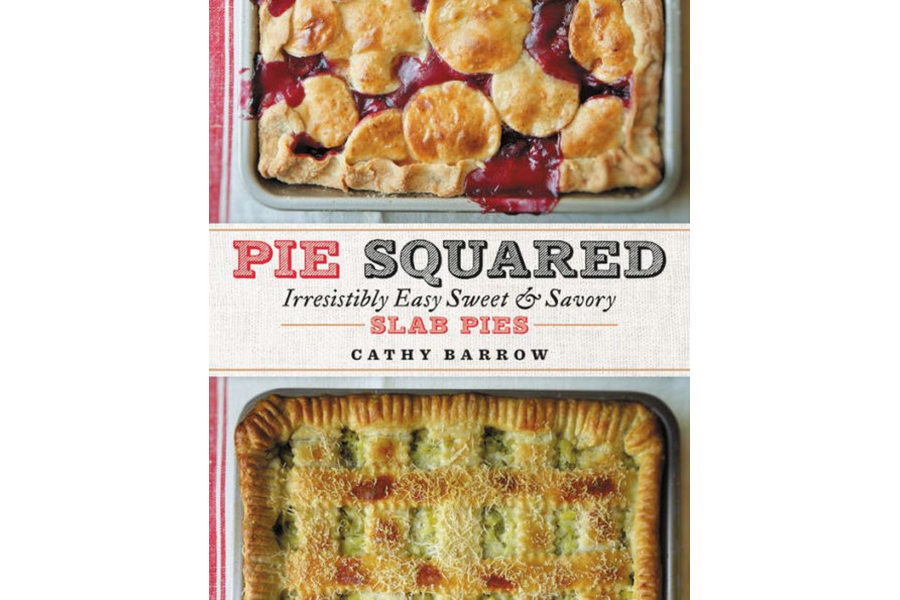Stress-free cooking during the holidays
Loading...
Like fashion, cookbooks ride on waves of cultural trends. One year, kale is the rage, another it’s kimchi. Right now, cauliflower is king: roasted whole, riced, curried, creamed, smothered in cheese, and carved into meaty “steaks” for searing and saucing. Whatever the reigning ingredients, all cookbooks aim to inspire your inner chef. But the holy grail these days is speed and ease – maximum flavor, satisfaction, and healthfulness in minimal time, all increasingly important if home cooking hopes to compete with takeout and meal kits.
My favorite new cookbook of the year is Cathy Barrow’s Pie Squared: Irresistibly Easy Sweet & Savory Slab Pies, even though I’m someone who would choose cookies over pie any day, including Thanksgiving. But these aren’t the gooey fruit oozers I associate with the American classic – in fact, half the recipes are savory, and many of the “Sweetie Pies” don’t even involve fruit.
None are round, so put away your pie dishes and pull out a baking sheet instead: These are slab pies, an unappealing word for an appealing way to feed a crowd or brighten a buffet.
Barrow’s clear instructions for more than a dozen kinds of crusts are a big selling point, but so is her Pan-Roasted Mushroom and Kale Slab Pie, which would make a great hors d’oeuvre or lunch entrée. Of course, Barrow hasn’t forgotten the holidays, with a slab pie recipe for leftover turkey and another that repurposes your cranberry sauce. And yes, there’s an Easy-as-Pie apple option, plus a modern variation with a cheddar cheese crust.
If cooking for a crowd isn’t your thing, check out Anita Lo’s Solo: A Modern Cookbook for a Party of One – whose recipes can be easily doubled. What she shares with Judith Jones’s “The Pleasures of Cooking for One” is a firm conviction that cooking for just yourself can be sophisticated and deeply satisfying.
Lo’s focus is less on classics and elaborate productions than on special ingredients, like her Duck Breast with Hoisin and Grapes. Recipes don’t get much simpler than her Kale Salad with Dates and Tahini Dressing: “Mix everything together. That’s it. Then eat it.”
Novelist Ann Hood’s Kitchen Yarns: Notes on Life, Love, and Food is a cozy collection of food-centric personal essays accompanied by recipes in the tradition of Laurie Colwin. Hood writes charmingly about what she ate during her Italian-American childhood in Rhode Island – lots of red “gravy,” some of it on her mother’s meatballs. Go-to comfort foods in times of sorrow often involve American cheese, but what she really sells you on is her Spaghetti Carbonara – “I am begging you, please do not put cream in your carbonara sauce!” – and her favorite custardy peach pie.
Dorie Greenspan, the prolific, Francophile “kitchen elf,” also shares some of her personal favorites in Everyday Dorie: The Way I Cook. Her gorgeous leprechaun-green Lettuce Soup, made with ingredients you’re likely to have on hand, is a keeper, as is her Summer Vegetable Tian, an easy, olive oil-drenched baked alternative to ratatouille. And Ellen Silverman’s accompanying photographs are so vibrantly real you want to take a fork to them.
Christopher Kimball knows that weeknight dinners are a race against the clock, so Milk Street: Tuesday Nights offers recipes grouped by speed of preparation, from Fast (under an hour) to Faster (45 minutes or less) to Fastest (25 minutes or less). There’s plenty to tempt even tired cooks, including a rich, flavorful Sausage and Mushroom Ragu with Pappardelle (45 minutes), lots of twists on no-fuss roasted chicken thighs requiring minimal active cooking time, and a bunch of satisfying dinner salads like Ginger Beef with Rice Noodles (40 minutes). Be warned, though, that recipes may take first-timers longer than he suggests.
Kimball’s former stomping ground, America’s Test Kitchen, celebrates 25 years with some of its all-time hits in Cook’s Illustrated Revolutionary Recipes. Their extensive experimentation spares home cooks common culinary disasters. Who knew that the best method for producing easy-to-peel hard-cooked eggs is to steam them? Or that you can avoid the wateriness that often afflicts vegetable lasagna by starting with pre-cooked veggies and substituting cottage cheese for ricotta to avoid graininess? This is a great book for novices and a helpful corrective for the rest of us.
Yotam Ottolenghi and Sami Tamimi’s “Jerusalem” unleashed a floodgate of Middle Eastern cookbooks. One of the latest is Michael Solomonov and Steven Cook’s Israeli Soul. Their swoon-
worthy hummus toppings, from charred zucchini with mint to ground beef with Turkish coffee, may just convince us that this “dip” can be the basis for a one-bowl meal.
Similarly, in Dosa Kitchen, Nash Patel and Leda Scheintaub make a convincing case for the versatility of another popular street food, South Indian dosas. These gluten-free rice and lentil pancakes – or crepes or wraps, depending on how thick you make them – are the perfect vehicle for curries, sprout salads, and their spicy chaat masala twist on hummus.
Meanwhile, Ottolenghi is back with another mouthwatering collection, Ottolenghi Simple. Just when I was wondering whether we really need another Ottolenghi cookbook, I came across his intriguing recipe for whole roasted celery root with coriander seed oil. So I guess the answer is yes. But note that simple doesn’t mean fast: The root needs to roast for three hours.
On the other end of the ease spectrum is this year’s culinary curiosity, The Noma Guide to Fermentation, by René Redzepi and David Zilber, from the world-famous Danish restaurant. This meticulously detailed guide to one of the oldest methods of food preservation is like an edible chemistry experiment that takes you step by step through the mechanics of building a fermentation chamber out of a plastic foam cooler, and the role of hydrogen in producing your own miso or dead-or-alive grasshopper garum (a funky, umami-rich relative of fish sauce). It adds up to fascinating reading for armchair cooks – or a novel challenge for intrepid culinary adventurers.





